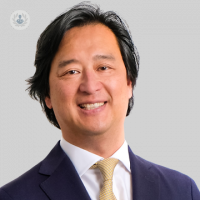The best type of glaucoma surgery for me: how an ophthalmologist decides on your glaucoma treatment
Written by:Glaucoma is a common condition, where fluid build-up in the eye causes the pressure to increase, which can lead to permanent optic nerve damage. Typically, this pressure is managed and treated through eye drops or simple laser treatment, but what if that is not enough? Here, expert ophthalmologist Mr Lim explains how patients are assessed for glaucoma surgery, and the different types available.

When is glaucoma surgery needed?
Glaucoma surgery becomes necessary when traditional drops used to manage glaucoma, or simple laser treatments such as SLT laser, are unable to control the pressure at a sufficiently low level to stop the glaucoma from getting worse.
When treating glaucoma, we always start the patient off on either simple laser treatments such as SLT, or drops treatment before recommending surgery. Overall, I think about 20% of the patients I see who have glaucoma will eventually go on to require glaucoma surgery in their lifetime.
How is a patient assessed for glaucoma surgery?
It is important to remember that glaucoma damage is a permanent damage to the eye. Therefore, if we do recommend glaucoma surgery, we must recommend it in a timely manner. For example, patients who are getting worse very rapidly may well need glaucoma surgery urgently, while a patient whose glaucoma is progressing at a much slower rate may not need urgent surgical intervention.
Therefore, with patients it is important to establish:
- Whether the patient has tried all routes of the regular simple drops treatment and simple laser treatment before recommending surgery.
- How quickly we need to perform the glaucoma surgery depending on the speed of the progression of their glaucoma.
What different kinds of surgery are available?
There are over ten types of glaucoma surgery which we can offer to patients, but it is easier to categorise them into three groups.
The first group is laser treatment, ranging from the simple SLT treatment (selective laser trabeculoplasty, a form of laser surgery which lowers intraocular pressure) which can be performed on patients, to more invasive laser treatments such as micropulse laser or ECP laser, which need to be performed in theatre.
The second group is a relatively new category which is called minimally-invasive glaucoma surgery (MIGS). This type of surgery tends to be much quicker to perform and also indicates much less intensive post-operative management. However, this group of surgical procedures tends not to achieve very low pressure post-operatively. This group will include; iStent, Hydrus and Kahook Double Blade.
Read more: glaucoma and eye stents
Finally, the third group is the more traditional glaucoma surgeries such as trabeculectomy, or implant surgery, which could include the XEN implant, Baerveldt implant or Ahmed valve implant.
Which is the most suitable glaucoma surgery for me?
It goes without saying that all the different types of glaucoma surgery carry certain advantages and disadvantages. It is important that we tailor different types of surgery to each patient presenting with a certain type of glaucoma, and the varying severity of their glaucoma. For example, patients with advanced glaucoma may need very low pressure post-operatively, therefore MIGS devices may not be suitable for those groups of patients.


